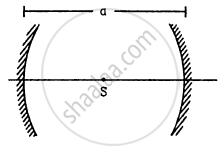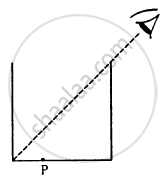Advertisements
Advertisements
प्रश्न
The diameter of the sun is 1.4 × 109 m and its distance from the earth is 1.5 × 1011 m. Find the radius of the image of the sun formed by a lens of focal length 20 cm.
उत्तर
Given,
Diameter of the sun = 1.4 × 109 m
Distance between sun and earth is taken as object distance (u) = − 150 × 1011 cm,
Focal length (f) of the lens = 20 cm
Using lens formula,
\[\frac{1}{v} - \frac{1}{u} = \frac{1}{f}\]
The object distance is very large as compared to focal length of the lens.
Hence, the image is formed at the focus.
\[\Rightarrow \frac{1}{v} = \frac{1}{20} - \frac{1}{150 \times {10}^{11}}\]
\[= \frac{750 \times {10}^9 - 1}{150 \times {10}^{11}}\]
\[\simeq \frac{750 \times {10}^9}{150 \times {10}^{11}}\]
\[\Rightarrow v = \frac{150 \times {10}^{11}}{750 \times {10}^9}\]
We know, Magnification (m) is given by:
\[(m) = \frac{v}{u} = \frac{h_2}{h_1}\]
\[\Rightarrow h_2 = \frac{v}{u} \times h_1\]
\[= \frac{150 \times {10}^{11}}{750 \times {10}^9 \times 150 \times {10}^{11}} \times 0 . 7 \times {10}^{12} mm\]
\[ = 0 . 93 mm\]
Hence, the required radius of the image of the sun is 0.93 mm.
APPEARS IN
संबंधित प्रश्न
Show with the help of a diagram, how unpolarised light from Sun gets linearly polarised by scattering.
Suppose you are inside the water in a swimming pool near an edge. A friends is standing on the edge. Do you find your friend taller or shorter than his usual height?
A parallel beam of light is incident on a converging lens parallel to its principal axis. As one moves away from the lens on the other side on its principal axis, the intensity of light
A convex lens is made of a material having refractive index
\[1 \cdot 2\] Both the surfaces of the lens are convex. If it is dipped into water (μ = 1.33), it will behave like
A concave mirror having a radius of curvature 40 cm is placed in front of an illuminated point source at a distance of 30 cm from it. Find the location of the image.
A concave mirror forms an image of 20 cm high object on a screen placed 5.0 m away from the mirror. The height of the image is 50 cm. Find the focal length of the mirror and the distance between the mirror and the object.
A concave mirror has a focal length of 20 cm. Find the position or positions of an object for which the image-size is double of the object-size.
A point source S is placed midway between two converging mirrors having equal focal length f as shown in figure. Find the values of d for which only one image is formed.
Locate the image of the point P as seen by the eye in the figure.

A cylindrical vessel, whose diameter and height both are equal to 30 cm, is placed on a horizontal surface and a small particle P is placed in it at a distance of 5.0 cm from the centre. An eye is placed at a position such that the edge of the bottom is just visible (see figure). The particle P is in the plane of drawing. Up to what minimum height should water be poured in the vessel to make the particle P visible?

Light falls from glass (μ = 1.5) to air. Find the angle of incidence for which the angle of deviation is 90°.
A container contains water up to a height of 20 cm and there is a point source at the centre of the bottom of the container. A rubber ring of radius r floats centrally on the water. The ceiling of the room is 2.0 m above the water surface. (a) Find the radius of the shadow of the ring formed on the ceiling if r = 15 cm. (b) Find the maximum value of r for which the shadow of the ring is formed on the ceiling. Refractive index of water = 4/3.
Fill in the blank and rewrite the completed statement:
Very fine particles mainly scatter ______ light.
State any one difference between a primary rainbow and a secondary rainbow.
A parallel beam of light of wavelength 5890 Å falls normally on a slit of width 0.2 mm. Find the distance between the first minima on the two sides of the central maximum of the diffraction pattern observed on a screen placed in the focal plane of a convex lens of focal length 50 cm. The lens is placed quite close to the slit.
| Case study: Mirage in deserts |
 |
|
To a distant observer, the light appears to be coming from somewhere below the ground. The observer naturally assumes that light is being reflected from the ground, say, by a pool of water near the tall object. Such inverted images of distant tall objects cause an optical illusion to the observer. This phenomenon is called mirage. This type of mirage is especially common in hot deserts. Based on the above facts, answer the following question: |
Which of the following phenomena is prominently involved in the formation of mirage in deserts?
A passenger in an aeroplane shall ______.
Between the primary and secondary rainbows, there is a dark band known as Alexandar’s dark band. This is because ______.
- light scattered into this region interfere destructively.
- there is no light scattered into this region.
- light is absorbed in this region.
- angle made at the eye by the scattered rays with respect to the incident light of the sun lies between approximately 42° and 50°.
